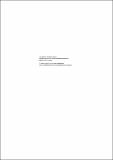| dc.contributor.author | Somerset, Anthony | |
| dc.date.accessioned | 2011-04-06T14:17:17Z | |
| dc.date.available | 2011-04-06T14:17:17Z | |
| dc.date.issued | 1973-11 | |
| dc.identifier.citation | Somerset, Anthony. (1973) Who goes to secondary school? efficiency, equity and relevance in secondary school selection. Discussion Paper 184, Nairobi: Institute for Development Studies, University of Nairobi | en_GB |
| dc.identifier.uri | https://opendocs.ids.ac.uk/opendocs/handle/20.500.12413/538 | |
| dc.description.abstract | Because the secondary school selection examination is so
crucial to the students' life chances, what is taught in Kenya's
primary schools is determined as much by the examination questions
as by the formal curriculum. This paper investigates the examination's
backwash effects as well as its efficiency in identifying pupils; who will
make the best use of secondary school opportunities.
At present the examination is mainly a selection instrument
geared to identifying secondary school entrants. It largely ignores
the interests of pupils for whom primary education is terminal. A
high proportion of the items test academic, specialised knowledge and
skills which are of little use to primary school leavers, most of
whom must create economic opportunities for themselves, in agriculture
or self-employment.
But, paradoxically, this reduces rather than improves the
efficiency of the examination as a selection instrument. Item analyses
of the 1970 and 1971 mathematics papers demonstrated that items which
test practical, everyday-mathematical skills are more efficient as
selectors than items which test secondary-level skills. The main
reason for this is that many teachers in low-cost schools (which make
up 99% of all primary schools in Kenya) do not themselves have an
adequate grasp of the more academic topics. The examination thus becomes
as much a test of the teachers as of the pupils. For this reason,
the examination is more efficient as a selection tool in high-cost, urban
schools than in low-cost, mainly rural, schools.
The intelligent pupil from a low-cost school is at a double
disadvantage in competition with a similar pupil from a high-cost school.
Because he has been less well educated, his total mark is likely to be
lower, by at least one standard deviation. In addition, his chances
of being identified as a pupil of high potential are much reduced because
of the lower efficiency of the examination in low-cost schools. Some
ways in which both the efficiency and the relevance of the examination
might be improved are suggested. | en_GB |
| dc.language.iso | en | en_GB |
| dc.publisher | Institute for Development Studies, University of Nairobi | en_GB |
| dc.relation.ispartofseries | Discussion Papers;184 | |
| dc.rights.uri | http://creativecommons.org/licenses/by-nc-nd/3.0/ | en_GB |
| dc.subject | Education | en_GB |
| dc.title | Who goes to secondary school? efficiency, equity and relevance in secondary school selection | en_GB |
| dc.type | Series paper (non-IDS) | en_GB |
| dc.rights.holder | Institute for Development Studies, University of Nairobi | en_GB |
| dc.identifier.blds | 322140 | |


